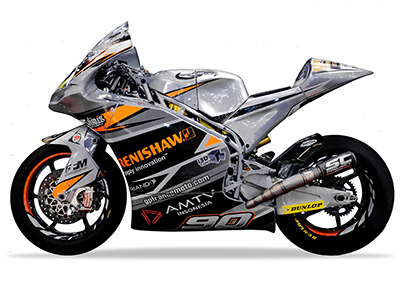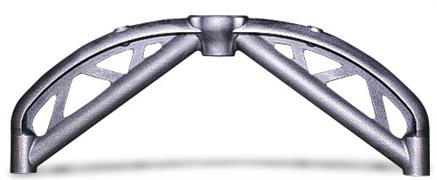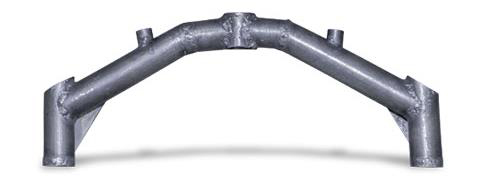In the fast-moving MotoGPTM motorcycle race, the improvement in vehicle performance has a great impact on the outcome of the race. The award-winning Moto2 team TransFIORmers has adopted an advanced additive manufacturing (metal 3D printing) technology in the innovative front suspension system, which has gained a huge competitive advantage. background The cars that appear in the MotoGP World Motorcycle Championships are all special models that the general public cannot access and buy, and they are not suitable for riding on the road. Motorcycle-specific motorcycles need to be customized – manufacturers have tried their best to ensure that their vehicles outperform their opponents and that the track performs best. Moto2 is the second of three levels of the MotoGP event and was founded in 2010. The official engine used at this level is the 600cc four-stroke mass production engine, currently supplied by Honda Japan. TransFIORmers is a Moto2 team from France, headquartered in Perigueux, in southwestern France, and is currently working to revolutionize the design of the front suspension to maintain the leading edge of the car. Renishaw sponsored TransFIORmers team Moto2 motorcycle The TransFIORmers team is led by Christian Boudinot, the 250cc class driver of the former Motorcycle World Championships, and its innovative suspension system is inspired by the French legend and motorcycle designer Claude Fior, who was a mentor and friend of Boudinot. Fior realized early on that the front suspension could be separated from the steering system for better performance. This design solves the problem of "brake dive", which enables the motorcycle to brake later when entering the corner and accelerate earlier when exiting the bend. Compared to conventional telescopic front fork suspensions, TransFIORmers motorcycles use a separate rigid front fork suspension system that is connected to the chassis via two fork arms. New TransFIORmer motorcycle fork arm To further optimize this innovative suspension design, TransFIORmers has found I3D Concept, a world leader in the field of metal additive design and manufacturing. I3D Concept worked closely with the TransFIORmers team to optimize the upper fork arm assembly with Renishaw's AM250 additive manufacturing system (two sets of fork arms together connect the fork to the chassis, which are important for motorcycle handling) design. i3D-Concept---Metal Additive Manufacturing Partner challenge In the design and development of new Moto2 motorcycle components, weight reduction is a priority, especially to reduce the "non-sprung mass" of motorcycles. The lighter the unsprung mass, the better the suspension's performance in vibration (jitter) control, and the faster it reacts to braking and acceleration. Equally important work includes improving the speed of new components and reducing the time it takes to reproduce. To be the best in a competitive environment, you need fast and accurate product iterations. In a competitive environment where high reliability is required, mechanical strength is another factor that needs to be considered. Only when the fork arm assembly of the TransFIORmers motorcycle achieves the highest level of rigidity can it handle the extremely high dynamic steering forces during driving. “In order to improve the overall performance of the motorcycle, the most important thing is to reduce the weight of all components behind the shock absorber. If the weight of the component cannot be optimized, it may adversely affect the shock absorption, braking and acceleration. Therefore, the weight loss is always It is a priority for us," said Jérôme Aldeguer, mechanical engineer at TransFIORmers. solution The original fork arm assembly of the TransFIORmers motorcycle is made of steel and is hand-built; it consists of twelve separately machined and welded parts. I3D Concept integrates the design into a single-piece assembly that significantly reduces assembly time. Original TransFIORmer fork arm consisting of 12 parts The company uses the Renishaw AM250 additive manufacturing system to produce metal 3D printing fork arms; they first prototyped with stainless steel and finally made lightweight parts with titanium. The key to the design of the new 3D component is the iterative process of topology optimization. Due to the strict space constraints of the body, the fork arm layout needs to be continuously planned by software to meet a series of predefined front fork load conditions. Once the final component design has been verified by digital CAD software, the molding preparation file can be generated offline and exported to the additive manufacturing system. Using CAD software, I3D Concept can evaluate whether the predetermined parameters are optimal, or whether parameters need to be adjusted to match specific metal powder characteristics and the complex target geometry of the fork arms. Importantly, using the AM250's dedicated Optical Control System (OCS) software, I3D Concept is able to control laser alignment very precisely, which helps improve machining accuracy and surface finish. result Through the use of additive manufacturing technology in the design of the Moto2 motorcycle, TransFIORmers has successfully reduced the weight of the key component of the fork-arm front suspension by 40%. Compared to the original steel welded components, the integrated titanium alloy assembly has a weight reduction of 600 g. Metal 3D printing also enables TransFIORmers to fine-tune component tolerances and quickly and flexibly iterate through the geometry of the fork arms to meet the structural requirements of specific chassis and motion systems. “Metal 3D printing helped us to reduce the weight of the fork arm assembly, which enabled us to avoid the weight transfer phenomenon of the vehicle and the problems associated with the 'brake dive'. Using this technology not only allows us to design the weight more Lightweight components also significantly increase their stiffness," explains Jérôme Aldeguer, mechanical engineer at TransFIORmers. The new Ti6AI4V titanium alloy fork arm made with additive manufacturing technology has an ultimate tensile strength of over 1100 MPa and a nearly perfect density of 99.7%. At the same time, its rigidity is far greater than that originally created by hand. A steel fork arm welded from multiple parts. Thanks to additive manufacturing technology, TransFIORmers' standard fork arm development process has become more cost effective. The time-consuming part processing and assembly work is eliminated, and the design iteration and manufacturing speed is increased several times. In June 2016, the team won the first Moto2 GP championship since its inception in the FIM CEV European Championships in Barcelona. Gold Plated Rca Plug,Speaker Plug Male Solderless,Rca Plug Speaker Plug Changzhou Kingsun New Energy Technology Co., Ltd. , https://www.aioconn.com




